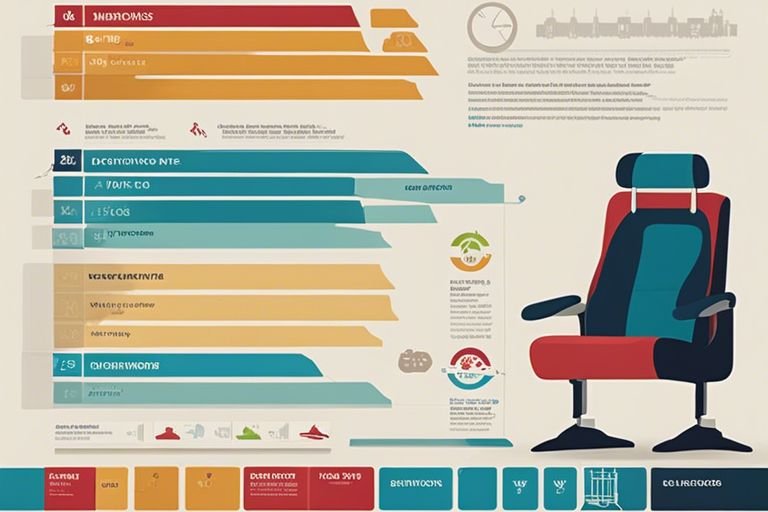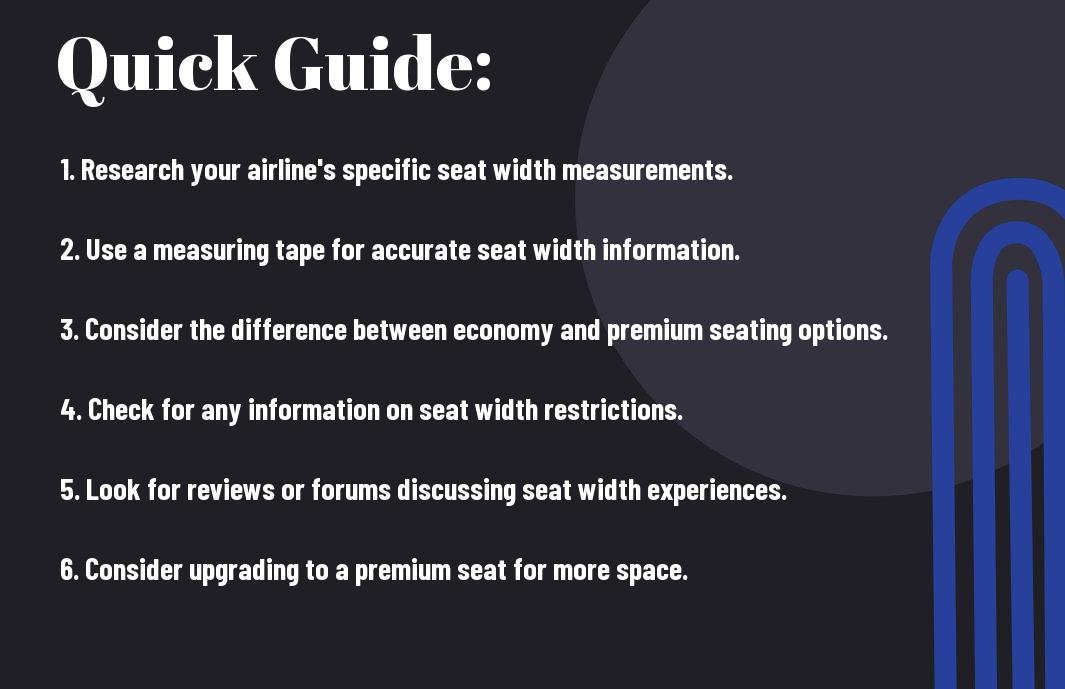How Wide Are Airplane Seats? A Guide to Airline Seating Dimensions
- Home
- How Wide Are Airplane Seats? A Guide to Airline Seating Dimensions

How Wide Are Airplane Seats? A Guide to Airline Seating Dimensions
As an avid traveler, I am always interested in finding the most comfortable airline seats for my journeys. Understanding the dimensions of airplane seats can make a significant difference in the quality of your flight experience. With the varying sizes of seats across different airlines and aircraft models, it’s crucial to have a clear understanding of the dimensions before booking your next flight. In this guide, I will provide you with comprehensive information on the average width of airplane seats, the potential dangers of cramped seating, and the airlines with the most spacious seating options. Whether you’re a frequent flyer or a first-time traveler, knowing the dimensions of airplane seats can help you make informed decisions for your future flights.
Key Takeaways:
- Airplane seat width can vary significantly depending on the airline and aircraft, with some seats as narrow as 16 inches and others as wide as 20 inches.
- Passengers should be mindful of seat width as it directly affects comfort, especially during long flights. Extra-wide seats are available with some airlines and can provide a more comfortable experience.
- Seat width might not be the only factor to consider when choosing a seat. Factors like seat pitch and seat layout can also impact the overall comfort of the passenger.
- Passengers with specific needs, such as those requiring extra space or individuals with mobility issues, should consider contacting the airline to discuss seating options and accommodations.
- SeatGuru and other similar resources can provide valuable information about seat dimensions and other important features, helping passengers make informed decisions about their seating choices.
Types of Airplane Seats
To help you understand the variety of seating options available on airplanes, I’ve broken down the different types of seats typically found on commercial flights. Here are the main categories:
- Economy Class
- Premium Economy Class
- Business Class
- First Class
Knowing the differences between these seat types can help you make the best choice for your travel needs.
Economy Class
Economy class seats are the most common and affordable option for air travel. They are typically smaller in size and have limited legroom. While they are not the most luxurious option, they can still provide a comfortable travel experience for short to medium-haul flights. However, it’s important to note that legroom and seat width can be somewhat limited in economy class, so it’s essential to choose the right seat for your comfort.
Premium Economy Class
Premium economy class is a step up from standard economy, offering extra legroom, wider seats, and other amenities to enhance the overall travel experience. This option is ideal for those looking for a bit more comfort without the hefty price tag of business or first class. With the additional space and amenities, premium economy class can offer a more enjoyable journey, especially on long-haul flights.
Business Class
Business class is designed for travelers who desire comfort, privacy, and premium services during their flight. These seats are significantly wider than economy and often recline into fully flat beds, allowing for a more restful experience on long flights. Business class passengers also have access to exclusive airport lounges and priority boarding, adding to the overall luxury of the travel experience.
First Class
First class is the epitome of luxury travel, offering spacious seats, gourmet dining, premium amenities, and personalized service. These seats are the widest and most comfortable on the plane, and they often come with additional perks such as private suites and onboard showers on select airlines. While first class comes with a higher price tag, for those seeking the ultimate in comfort and luxury, it is well worth the investment.
Tips for Choosing the Right Seat
Clearly, choosing the right seat can make a big difference in your comfort during a flight. Here are some tips to help you make the best decision:
- Consider your personal preferences and needs, such as legroom, seat width, and proximity to the bathroom.
- Use online tools like SeatGuru to research seat dimensions and read reviews from other passengers.
- Be aware of potential obstructions, such as non-reclining seats, limited legroom, or proximity to restrooms.
Assume that choosing the right seat can greatly impact your overall flight experience. Taking the time to research and plan ahead can ensure a more enjoyable trip.
SeatGuru and Similar Resources
When it comes to finding the best seat on an airplane, tools like SeatGuru can be invaluable. SeatGuru provides detailed seating maps for most major airlines, allowing you to research seat dimensions, legroom, and other important details. You can also read reviews from other passengers to get a better idea of what to expect from specific seats.
Window vs. Aisle Seats
Deciding between a window and aisle seat often comes down to personal preference. Window seats offer a view and a solid surface to lean against, while aisle seats provide easier access to the restroom and more legroom. Consider your priorities when making this choice.
Legroom and Seat Pitch
Legroom and seat pitch are crucial factors in determining overall comfort during a flight. Legroom refers to the amount of space between your seat and the seat in front of you, while seat pitch is the distance from one seat to the same point on the seat in front. Pay attention to these measurements when choosing a seat.
Seat Width and Comfort
When it comes to seat width and comfort, larger passengers or those who appreciate extra space should prioritize seats with ample width. Keep in mind that narrower seats may be uncomfortable for longer flights, so choose wisely based on your needs and preferences.
Factors Affecting Airplane Seat Dimensions
After years of experience in the airline industry, I have learned that several factors affect the dimensions of airplane seats. These factors can range from the type of aircraft being used to the policies of the airline. Understanding these factors can help you make an informed decision when choosing your seat for your next flight.
Aircraft Type
When it comes to the dimensions of airplane seats, the type of aircraft being used plays a crucial role. Different aircraft have varying cabin widths and seating configurations, which directly impact the dimensions of the seats. For example, larger aircraft such as wide-body planes typically offer more seat width and legroom, while smaller regional jets may have narrower seats and less space between rows.
Airline Policies
Another important factor that influences the dimensions of airplane seats is the policies of the airline. Some airlines are known for offering more spacious seating options with extra legroom for an additional fee, while others may have a standard seat size across all their aircraft. Additionally, certain airlines may have restrictions on the dimensions of carry-on items, which can impact the available space around your seat.
Passenger Size and Comfort
It’s essential to consider the size and comfort of passengers when determining seat dimensions. Airlines strive to accommodate a diverse range of passengers, but individuals with larger body types might find standard seat dimensions uncomfortable. Factors such as hip width and shoulder room can significantly impact passenger comfort, especially during long flights.
Cabin Configuration
The cabin configuration of an aircraft is another influential factor in determining seat dimensions. This includes factors such as the number of seats in a row, the arrangement of seats, and the presence of bulkheads or exit rows. Cabin configuration can impact the overall comfort level of passengers, as well as the available amenities such as in-seat entertainment and storage space.
Pros and Cons of Different Airplane Seat Types
For travelers, choosing the right airplane seat is an important decision that can greatly affect the comfort of their journey. Here is a breakdown of the pros and cons of different airplane seat types:
| Economy Class | Premium Economy, Business, First Class |
| More affordable | More comfortable |
| Limited legroom | More spacious |
| Smaller seat width | Enhanced amenities |
| No extra perks | Priority boarding and check-in |
| Higher chances of overbooking | More attentive service |
Economy Class
When flying in Economy Class, you can expect a more affordable ticket price, but this comes with the trade-off of limited legroom and a smaller seat width. While you may not have access to the extra perks and amenities that come with premium seating, such as priority boarding and enhanced service, Economy Class can still get you to your destination at a reasonable cost.
Premium Economy Class
Choosing Premium Economy Class can provide a more comfortable experience with extra spacious seating and enhanced amenities. This option often comes with priority boarding and check-in, as well as more attentive service from the airline staff. However, it typically comes with a higher price tag compared to Economy Class.
Business Class
Business Class offers passengers a more luxurious flying experience with spacious seating and a range of enhanced amenities. This seating option also provides priority boarding and check-in, as well as more attentive service from the airline staff. However, the cost of a Business Class ticket is significantly higher than Economy or Premium Economy.
First Class
For the ultimate in comfort and luxury, First Class is the way to go. With the most spacious seating and an array of high-end amenities, flying First Class can make your journey truly exceptional. In addition to priority boarding and check-in, you can expect the highest level of attentive service. However, this comes with a steep price tag compared to other seating options.
I hope this guide helps you make an informed decision about the right airplane seat type for your next journey.

The Wide Variety of Airplane Seat Sizes
The wide variety of airplane seat sizes can make it difficult to know what to expect when booking a flight. After researching and compiling data on airline seating dimensions, I have found that there is a significant variance in seat widths across different airlines and aircraft models. When booking your next flight, it’s important to consider the dimensions of the seats to ensure a comfortable and enjoyable travel experience. Whether you’re looking for extra room or simply want to know what to expect, understanding the wide range of airplane seat sizes is essential for every traveler. By taking the time to research and compare dimensions, you can make informed decisions and select the best seating option for your needs.
FAQ
Q: How wide are airplane seats?
A: Airplane seat width can vary, but the standard economy class seat width on most airlines is between 17 and 18 inches. However, some airlines offer wider seats, particularly in premium economy and business class. It’s important to check with your specific airline for their seat width dimensions.
Q: Can I get a wider seat on an airplane?
A: Yes, some airlines offer wider seats in premium economy and business class. These seats can range from 19 to 22 inches wide, offering more comfort for passengers. However, these seats typically come with a higher price tag. It’s best to check with the airline and consider your budget and seating preferences.
Q: Are there regulations for airplane seat width?
A: Currently, there are no specific regulations for airplane seat width in the United States. The Federal Aviation Administration (FAA) sets requirements for safe evacuation of aircraft, but seat width is not directly addressed in these regulations. However, there have been discussions about setting minimum seat size standards in the industry.
Q: What can I do if I need more space in a standard airplane seat?
A: If you require more space in a standard airplane seat, you can consider selecting a seat with extra legroom or upgrading to a premium economy or business class seat with wider dimensions. Additionally, some airlines allow passengers to purchase an additional seat if they need more space due to personal comfort or medical reasons.
Q: Are there specific airlines known for offering wider seats?
A: Yes, certain airlines are known for providing wider seats in their cabins. These could include international carriers, premium economy-focused airlines, and some low-cost carriers that offer wider seats as part of their premium offerings. It’s important to research and compare different airlines’ seating options when booking a flight.
- Share
Mark Twain
Mark Twain stands at the helm of Create More Flow, infusing every sentence with the wisdom of his 15-year expeience through the seas of SEO and content creation. A former BBC Writer, Mark has a knack for weaving simplicity and clarity into a tapestry of engaging narratives. In the realm of content, he is both a guardian and a guide, helping words find their flow and stories find their homes in the hearts of readers. Mark's approach is grounded in the belief that the best content feels like a chat with an old friend: warm, inviting, and always memorable. Let Mark's expertise light up your website with content that's as friendly to Google as it is to your audience. Each word is chosen with care, each sentence crafted with skill - all to give your message the human touch that both readers and search engines love.
